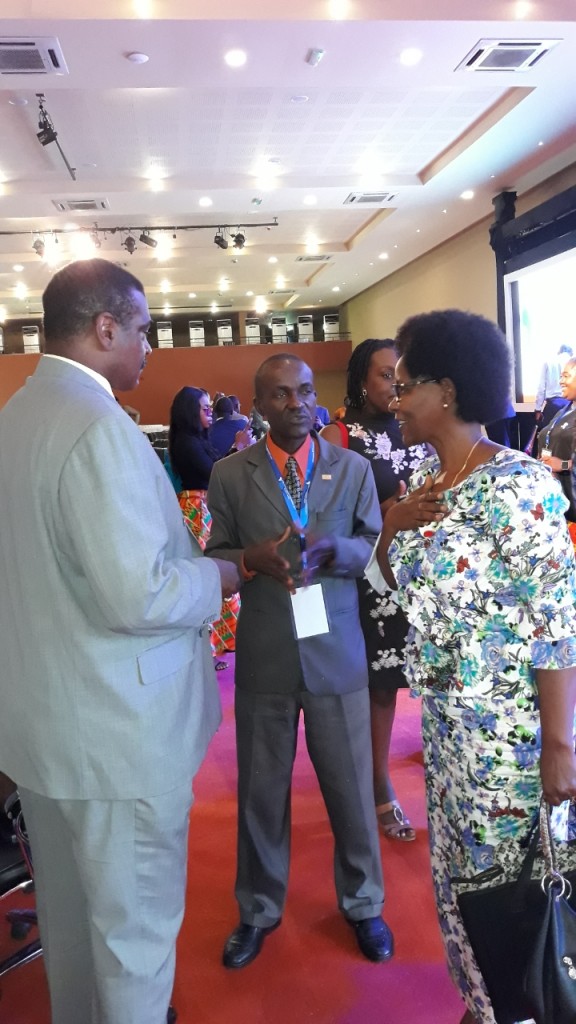National Association of Social Workers Chief Executive Angelo McClain, PhD, LICSW delivered a keynote address today at the International Federation of Social Workers (IFSW) Africa Region Conference in Kampala, Uganda. Here are his remarks:
 I’m so pleased to be here in Kampala in Uganda in Africa for many, many reasons it warms my soul to be with you today. To learn, to collaborate, to inspire, to continue the work towards “The Promised Land” of social, economic, political and environmental justice for all people whomever they may be and wherever they might live.
I’m so pleased to be here in Kampala in Uganda in Africa for many, many reasons it warms my soul to be with you today. To learn, to collaborate, to inspire, to continue the work towards “The Promised Land” of social, economic, political and environmental justice for all people whomever they may be and wherever they might live.
The pursuit of social, economic and political transformation requires extraordinary leadership—the kind of leadership that causes significant and lasting change in individuals, families, communities and social systems. Transformative social work leadership presents an innovative and integrative approach that interweaves micro, mezzo, and macro methods for achieving collective impactful for the entrenched social issues commonly addressed by social workers. Transformative leadership is about reshaping our notions of transformation as change that manifest itself as a collective effort that specifically addresses the structural barriers to profound social change.
I taught a leadership class for six years at Simmons University. Each semester I started the class by asking two questions: Leaderships Is? And Leadership for what? I responded to that questioning look in my students’ eyes by saying, “When you understand these fundamental questions, you will not only understand leadership you will have a relentless desire to unleash its power for social good.
Leadership Is? And Leadership for What?
It’s been said that there are two kinds of power – organized money and organized people. Through collective impact we are able to organize both of these precious resources: money and people – not necessarily in that order.
Transformational leadership occurs when one or more persons engage with others in such a way that leaders and followers raise one another to higher levels of motivation and morality. “Leadership” is Pulitzer Prize-winner James M. Burns’ pioneering study of leadership, first published in 1978 and still considered the seminal work in the field of leadership studies. In it Burns introduced the influential theory of ‘transformational leadership,’ which states that the best leaders are those who inspire others to come together toward the achievement of higher aims, a theory that has been the basis of more than 400 doctoral dissertations.
Speaking to the first question: What is transformational leadership? Several years ago, I wrote a column that appeared in the NASW News, entitled “Transformative Social Work Leadership,” speaking to the importance of transformative leadership for social work and how this leadership style is congruent with the altruistic values of social work articulated in the NASW code of Ethics.
I want to start the discussion by drawing a contrast between transactional and transformative leadership. Transactional leadership is about rank, position, follower compliance, leader authority, and has a short-term focus. On the other hand, transformational leadership is about character, competence, commitment, follower development, leader’s values and has a long-term focus.
Transformational leadership is a flexible leadership style for leading change through engagement, motivation, persuasion, and influence that breaches the natural resistance to change. A departure from traditional and reactive management styles, transformational leadership provides a proactive and engaging way to inspire happy and productive teams. I want to emphasize that transformational leadership is a tool that social work leaders can use to transform and motivate team members.
I want to now share the four I’s of Transformational Leadership: idealized influence, inspirational motivation, individual consideration and intellectual stimulation. In the next few slides, I will delve further into the four I’s of transformational leadership and their application to social workers committed to developing the competencies needed for exemplary leadership.
Idealized Influence is the ability of a charismatic leader to generate enthusiasm and optimism for their vision and serve as a role model for highly ethical behavior. They instill admiration, respect and trust in followers and influence others to want to emulate their leadership.
Idealized influence is best expressed through a leader’s willingness to take calculated risks and follow a core set of values, convictions and ethical principles in the actions they take. It is through this concept of idealized influence that the leader builds trust with followers and the followers, in turn, develop confidence in their leader.
 Leaders with idealized influence go for the highest achievements possible, focusing on a big brilliant dream that’s larger than life. They focus on the reasons why they can achieve their dream instead of focusing on barriers. They proactively translate their vision into goals and objectives and lead others on the journey to achieving them.
Leaders with idealized influence go for the highest achievements possible, focusing on a big brilliant dream that’s larger than life. They focus on the reasons why they can achieve their dream instead of focusing on barriers. They proactively translate their vision into goals and objectives and lead others on the journey to achieving them.
Inspirational Motivation refers to the leader’s ability to instill confidence, belief in the cause, and high expectations for followers. It involves providing meaning to the challenge and future aspirations and instilling a sense of hope and accomplishment in team members.
Leaders with inspirational motivation challenge followers with high standards, communicate optimism about goals, and provide meaning for the task at hand. The visionary aspects of leadership are supported by superb communication skills that make the vision understandable, precise, powerful and engaging.
The transformational leader articulates a clear vision for the future, communicates expectations and demonstrates a commitment to the goals and objectives. Followers are motivated and driven to move forward by having a strong sense of purpose.
Individual Consideration is the ability to know team members, coach and mentor them, and provide opportunities for them to meet their personal goals. It is a concept based upon leaders listening to the needs of team members. Individual consideration pivots on being able to see others’ perspectives and through being open to and considering others’ points of view, which comes through listening to others, being broad-minded, asking for others’ opinions and considering them as a course of action is chosen.
Each follower has specific needs and desires and have intrinsic motivation for their tasks. For example, some are motivated by money while others by change and excitement. The individualized consideration element of transformational leadership recognizes these needs. The leader must be able to recognize what motivates each member. Through one-on-one coaching and mentoring, the transformational leader provides opportunities for customized training sessions for each team member, which allows team members to grow and become fulfilled in their positions.
Intellectual Stimulation is defined as having a leader who values and encourages innovation and creativity, as well as critical thinking and problem-solving. Intellectual stimulation involves arousing followers’ thoughts and imagination, as well as stimulating their ability to identify and solve problems creatively.
Leaders with this style stimulate and encourage followers to be innovative and creative by questioning assumptions, reframing problems and approaching old situations in new ways. They nurture and develop people who think independently. The followers ask questions, think deeply about matters and figure out better ways to execute their tasks. The leader supports followers by involving them in the decision-making process and stimulating their efforts to be as creative and innovative as possible to identify solutions.
The skills most needed to deliver results and growth are related to interpersonal skills more than technical or functional expertise. A balanced approach is needed that focuses on both technical/functional skills and interpersonal skills, such as: communication, relationships, problem-solving, prioritization, delegation, commitment, creativity, strategic thinking, emotional Intelligence, decision-making. However, the transformative leader needs additional resources that are equally important to these skills.
When you think about the skill sets, attributes, and capacities required of leaders in the current atmosphere of urgency, high-stakes, economic instability, and demands for equity and justice, remember the critical importance of a clear mandate, a solid cohesive leadership team, and a strategic plan that sets forth the roadmap for success.
Transformational leadership requires the leader to have deep personal resolve. When I taught, I told my students, “Your personal resource reservoir is far deeper than you’ll ever imagine. Nelson Mandela once said, “That our biggest fear is not that we are powerless, our biggest fear is that we are powerful beyond belief.” You might ask, “if so, then why don’t we act?” One word: responsibility. We’d prefer that action and responsibility were easier burdens to bear. In their book entitled; leadership on the line Heifetz and Linsky (Harvard University Faculty, speak quite eloquently to the dangers of leadership.
My biggest lesson in transformational leadership was understanding the importance of continuous learning and improvement. There’s a continuous need to improve, to innovate, and to integrate—as human beings we naturally tend toward working in silos. At all times, we must make knowledge-informed decisions and we must keep the fear of failure in its place; not through denial, avoidance or struggle, but through fully embracing the fear and its underlying message to keep going, to prepare more, to fill-in the gaps in your learning and leadership.
Leading through crisis is always an opportunity to test your leadership metal: can you stay the course; can you over-communicate and be overly inclusive; can you be authentic and vulnerable; can you suspend judgement and provide support; can you set the many excuses to the side (time for that late)r; can you embrace the truth that the crisis is not impossible, it’s merely difficult; do you have what it takes to leverage the crisis for good.
 People admire leaders who awaken their curiosity, challenge them to think and learn, and encourage openness to new, inspiring ideas and alternatives. They appreciate being encouraged to try new approaches, not being criticized when their ideas differ from the leader’s; and being respected and celebrated for the individual contributions they make to the team. The transformational leadership model is well-suited for social workers leading transformative individual, community, organizational and societal change.
People admire leaders who awaken their curiosity, challenge them to think and learn, and encourage openness to new, inspiring ideas and alternatives. They appreciate being encouraged to try new approaches, not being criticized when their ideas differ from the leader’s; and being respected and celebrated for the individual contributions they make to the team. The transformational leadership model is well-suited for social workers leading transformative individual, community, organizational and societal change.
The social, economic, and political development and justice we seek requires understanding the interactions between different parts of a system and how together they effect change, rather than trying to understand specific components in isolation. Systemic change to remove the barriers to development and justice must be built on transformational and sustainable change.
Ultimately, we desire social change that helps people gain control over their own lives and have the confidence and self-esteem to act on issues they identify as important; economic change that gives people access to secure and sustainable incomes and livelihoods; and political change wherein people have the capacity to analyze, organize, and mobilize to change policies, practices, and institutional systems.
It is often quoted that “The single biggest failure of leadership is to treat adaptive challenges like technical problems.” This follows in research administration as well. As problems arise, and change management becomes part of your daily life, you begin to recognize the difference between solving an easy technical glitch and strategizing to effect organizational adaptive change.
Some leadership challenges may require a change in just one local place, while others may extend to the furthest organizational boundaries. People are generally receptive to technological problems because they recognize the need and solutions can be implemented easily. Adaptive challenges are more difficult to identify and organize around.
Sustainable progress requires working at many levels simultaneously – individual, household, community, and national. Change at an individual level is unsustainable without positive change in organizations and government policy. Likewise, national policy development may not be effective without working to address changes in communities and households.
The transformative approach to achieving transformation, whether in economic, political or social spheres, requires changes at both the individual, family and community levels as well as systemic levels. Change is also required at both the informal level in rules and practices and the formal level in terms of institutional rules, laws and governmental policies.
Four principles for achieving transformation regardless of where you might be in the system:
- Increase the voice – of those we seek to help in the household, in communities, in institutions and in political spaces.
- Take a systems approach – to the complex web of social, economic and political factors that negatively impact on people’s access to power; create meaningful and sustainable supportive social and economic activities.
- Build partnerships that embed ownership in local systems – focusing on specific opportunities that are feasible with specific groups within their context and building partnerships across a range of actors to advance those.
- Challenge social norms and improve social inclusion – convene stakeholders to address the social norms that dictate the expected societal roles (less than, more than, less deserving, more deserving, better than).
Leaders are not born but evolve into that role. According to Warren Bennis, a noted authority on leadership, “The most dangerous leadership myth is that leaders are born—that there is a genetic factor to leadership. In fact, the opposite is true. Leaders are made rather than born.”
Perhaps President John F. Kennedy put it best when he observed, “Leadership and learning are indispensable to each other.” Leaders learn to become leaders, and they continue to learn in their role as leaders.
Traditional approaches are not solving our toughest and most complex challenges. We must understand that social problems – and their solutions – arise from interaction of many organizations within the larger system. Cross-sector alignment with government, nonprofit, philanthropic and corporate sectors as partners. Organizations actively coordinating their actions, sharing lessons, working toward the same goal, and measuring the same things can best be described as collective impact. There are five elements of the collective impact approach: common agenda, shared measurement, mutually reinforcing activities, continuous communication, and backbone organizations.
The collective impact approach can apply to solving many complex social Issues: education, healthcare, homelessness, workforce development, economic development, and community development. Working in collective impact requires a mindset shift from adaptive to technical problems and solutions, supporting common agenda building, information sharing, and problem-solving coordination and alignment. Collective impact coordination happens through cascading levels of linked collaboration, common agenda steering, shared measures, committee governance, vision and strategy working groups, action planning, and backbone partners.
Through the collective impact approach, organizations work collaboratively to achieve a perpetual state of simultaneous planning and doing, prepare themselves for “shock of the possible,” pay attention to relationships, listen for how to respond to unanticipated results, use data points to guide the way, and adopt a mindset of “burning patience.”
Shared measurement is a critical piece of pursuing a collective impact approach. Identifying common metrics for tracking progress toward a common agenda across organizations, and providing scalable platforms to share data, discuss learnings, and improve strategy and action. The benefits of using shared measurement, include improved data quality, tracking progress toward a shared goal, enabling coordination and collaboration, learning and course correction, and catalyzing action.
It is not always easy to see the value of a backbone organizations’ work. The role of backbone organizations Is best described as facilitation and doing the behind the scenes work. They are an umbrella that can say, “This is an issue, let‘s address it together.” They serve as the voice that brings issues to the table that may not otherwise be heard. The backbone organization forms a bridge between all of the players under the big tent. Effective backbone organization leadership is critical to collective impact success.
In my family, I was taught, “Those who can, must.” Those who can step-up and take on leadership roles, must! As a social work leader, you must always strive to “be the best you can be.” You ask, “What difference does it make?” It makes a big difference; your skill set, your leadership could possibly be the difference between for example positive youth development and putting lives at risk, at great risk!
You did not wake up one day and learn: “oh, I’m going to be a social worker.” No, you transformed yourself into the professional social you are through hard work, disciplined study, and a relentless passion to make a difference in this world.
ISFW Africa, my wish for you is that, “You wholeheartedly embrace the transformative leader that’s within you; that you go forth and cause the significant and lasting alternative futures you pray, hope and dream of for your clients, your communities, and the world.”





